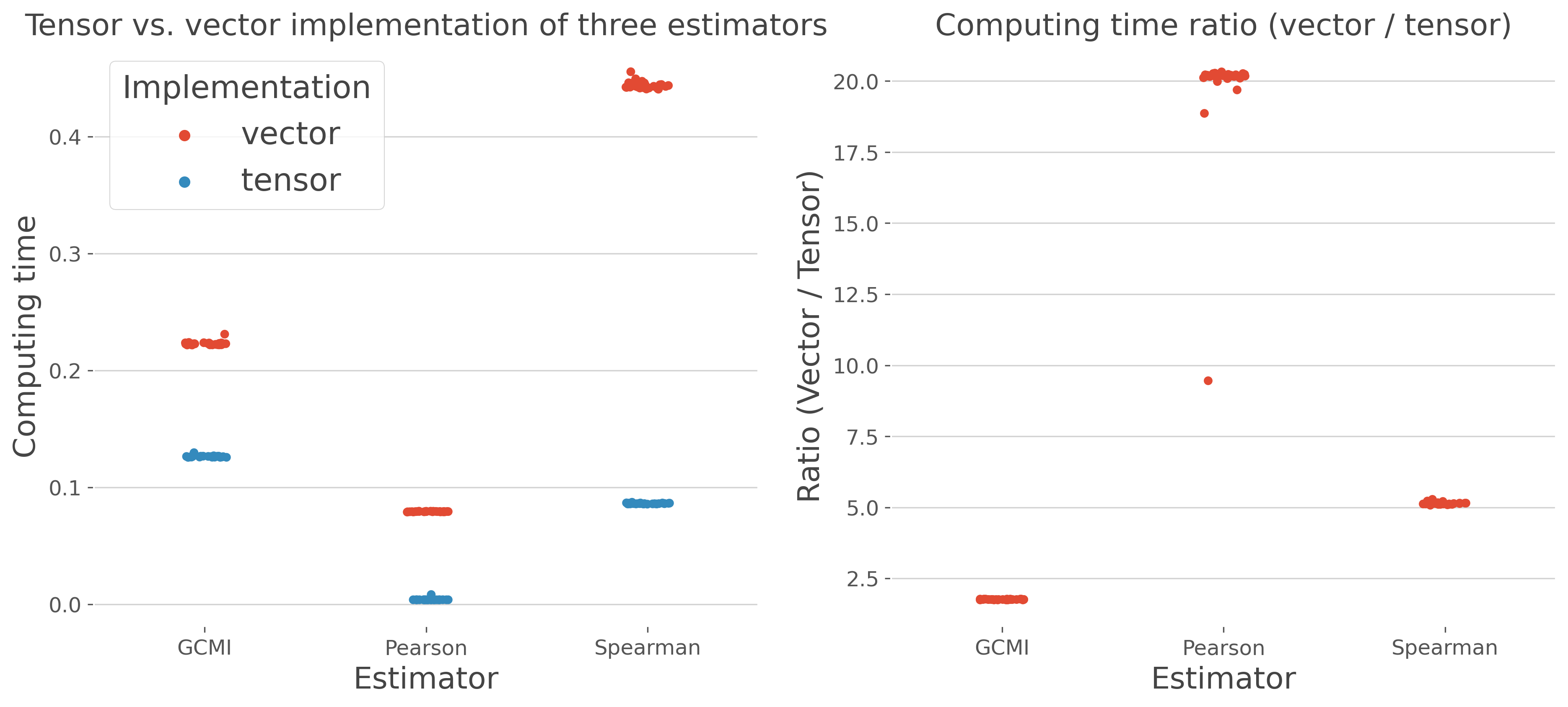Note
Go to the end to download the full example code.
Comparison between tensor and vector based computations#
In this example, we compared the elapsed computing time when using a vector based implementation (i.e. operations between vectors inside nested for loops) with a tensor-based implementation (i.e. operations on the full array at once).
import numpy as np
import pandas as pd
from frites.estimator import GCMIEstimator, CorrEstimator
from frites import set_mpl_style
from time import time
import matplotlib.pyplot as plt
import seaborn as sns
set_mpl_style()
Define a dataset#
In this first section, we define two multi-dimensional variables x and y
# shape of the two variables
shape = (1000, 1, 400)
# define the x and y variables
x = np.random.rand(*shape)
y = np.random.rand(*shape)
Define vector- and tensor-based estimators#
Next, we define three estimators of information : Gaussian-Copula Mutual information, Pearson and Spearman correlations with both vector and tensor-based computations
# vector-based estimators
vec_est = {
'GCMI': GCMIEstimator(mi_type='cc', tensor=False),
'Pearson': CorrEstimator(implementation='vector'),
'Spearman': CorrEstimator(method='spearman', implementation='vector'),
}
# tensor-based estimators
ten_est = {
'GCMI': GCMIEstimator(mi_type='cc', tensor=True),
'Pearson': CorrEstimator(implementation='tensor'),
'Spearman': CorrEstimator(method='spearman', implementation='tensor'),
}
Computing time estimation#
In this first section, we define two multi-dimensional variables x and y
# number of loops for repeating computations
n_loops = 30
# function for estimating the computing time
def computing_time(estimator):
"""Estimate computing time."""
tot_time = []
for k in range(n_loops):
start = time()
estimator.estimate(x, y)
end = time()
tot_time.append(end - start)
return tot_time
# computing time for all of the methods
meth_name, meth_imp, comp_time, comp_name, comp_ratio = [], [], [], [], []
for name in vec_est.keys():
# vector computations
meth_name += [name] * n_loops
meth_imp += ['vector'] * n_loops
_time_vec = computing_time(vec_est[name])
comp_time += _time_vec
# tensor computations
meth_name += [name] * n_loops
meth_imp += ['tensor'] * n_loops
_time_ten = computing_time(ten_est[name])
comp_time += _time_ten
# computing time ratio
comp_name += [name] * n_loops
comp_ratio += (np.array(_time_vec) / np.array(_time_ten)).tolist()
# merge the results in a dataframe
results = pd.DataFrame({
"Estimator": meth_name,
"Implementation": meth_imp,
"Computing time": comp_time,
})
results_comp = pd.DataFrame({
"Estimator": comp_name,
"Ratio (Vector / Tensor)": comp_ratio
})
# plot the results
plt.figure(figsize=(15, 6))
plt.subplot(121)
sns.stripplot(
data=results, x='Estimator', y='Computing time', hue='Implementation'
)
plt.title("Tensor vs. vector implementation of three estimators")
plt.subplot(122)
sns.stripplot(
data=results_comp, x='Estimator', y='Ratio (Vector / Tensor)',
)
plt.title("Computing time ratio (vector / tensor)")
plt.show()

Note
As shown in the results, the tensor-based implementations are at least twice as fast compared to the vector-based computations
Total running time of the script: (0 minutes 27.563 seconds)
Estimated memory usage: 395 MB